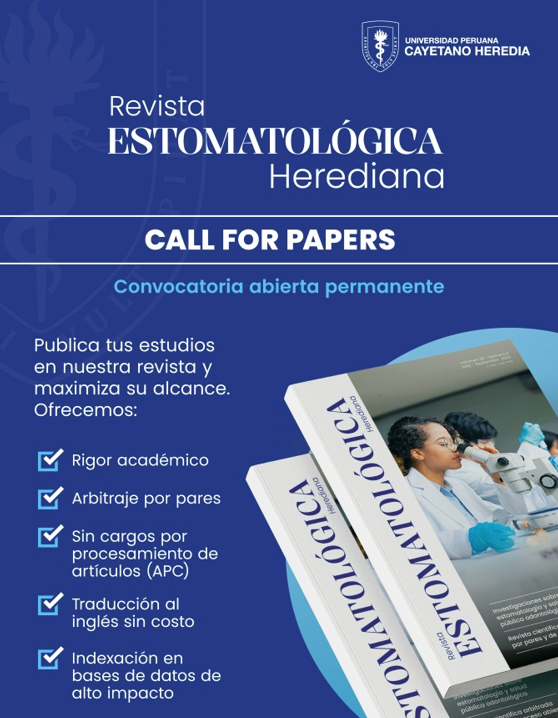Uso del microarenador intraoral para colocación de selladores de fosas y fisuras: Caso clínico.
DOI:
https://doi.org/10.20453/reh.v32i3.4292Palabras clave:
Microarenador, aire abrasivo, selladores de fosas y fisuras, esmalte, prevenciónResumen
Los selladores de fosas y fisuras han demostrado ser una alternativa eficiente y eficaz para proteger las superficies oclusales del desarrollo de lesiones cariosas. Se realiza una revisión del aire abrasivo usado en odontología resturadora y se presenta un caso clínico del uso de esta tecnologia para la colocación de selladores de fosas y fisuras.
Descargas
Citas
The glossary of prosthodontic terms: ninth edition. J Prosthet Dent. 2017;117(5S):e1-e105. doi: 10.1016/j.prosdent.2016.12.001
Milly H, Austin RS, Thompson L, Banerjee A. In vitro effect of air- abrasion operating parameters on dynamic cutting characteristics of alumina and bio-active glass powders. Oper Dent. 2014;39(l):81-89.
Huang CT, Kim J, Arce C, Lawson NC. Intraoral Air Abrasion: A review of devices, materials, evidence, and clinical applications in restorative dentistry. Compend Contin Educ Dent. 2019;40(8):508-514.
Malterud M. Air abrasion: the new renaissance with an H20 twist. Dent Today. 2010;29(10):146-149.
Malmstrom HS, Chaves Y, Moss ME. Patient preference: convention al rotary handpieces or air abrasion for cavity preparation. Oper Dent. 2003;28(6):667-671.
Banerjee A, Uddin M, Paolinelis G, Watson TF. An investigation of the effect of powder reservoir volume on the consistency of alumina powder flow rates in dental air-abrasion devices. J Dent. 2008;36(3):224-227.
Paolinelis G, Banerjee A, Watson TF. An in-vitro investigation of the effects of variable operating parameters on alumina air-abrasion cut ting characteristics. Oper Dent. 2009;34(1):87-92.
Mujdeci A, Gokay O. The effect of airborne-particle abrasion on the shear bond strength of four restorative materials to enamel and dentin. J Prosthet Dent. 2004; 92(3): 245-249.
Los SA, Barkmeier WW. Effects of dentin air abrasion with alumium oxide and hydroxyapatite on adhesive bond strength. Oper Dent. 1994;19(5):169-175.
Kern M, Thompson VP. Sandblasting and silica-coating of dental alloys: volume loss, morphology and changes in the surface composition. Dent Mater. 1993;9(3):151-161.
Inokoshi M, De Munck J, Minakuchi S, Van Meerbeek B. Meta-analysis of bonding effectiveness to zirconia ceramics. J Dent Res. 2014:93(4): 329-334.
Spitznagel FA, Horvath SD, Guess PC, Blatz MB. Resin bond to in direct composite and new ceramic/polymer materials: a review of the literature. J Esthet Restor Dent. 2014; 26(6):382-393.
Sauro S, Watson TF, Thompson I. Dentine desensitization induced by prophylactic and air-polishing procedures: an in vitro dentine perme ability and confocal microscopy study. J Dent. 2010;38(5):411-422.
Barnes CM, Covey D, Watanabe H, et al. An in vitro comparison of the effects of various air polishing powders on enamel and selected esthetic restorative materials, J Clin Dent. 2014;25(4):76-87.
Graumann SJ, Sensat ML, Stoltenberg JL. Air polishing: a review of current literature. J Dent Hyg. 2013;87(4):173-180.
Descargas
Publicado
Cómo citar
Número
Sección
Licencia
Los autores conservan los derechos de autor y ceden a la revista el derecho de primera publicación, con el trabajo registrado con la Licencia de Creative Commons, que permite a terceros utilizar lo publicado siempre que mencionen la autoría del trabajo, y a la primera publicación en esta revista.























